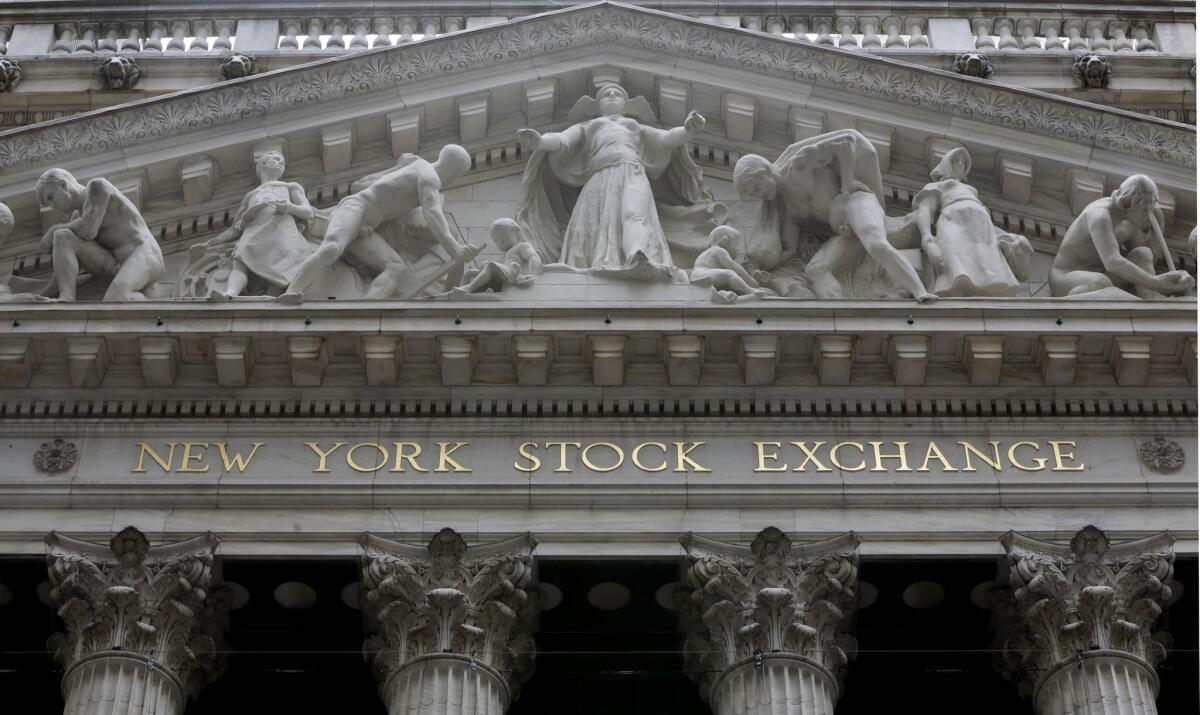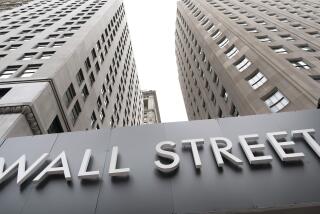Stocks slip, pulling S&P 500 into the red for the year

The facade of the New York Stock Exchange.
- Share via
U.S. stocks closed lower Thursday, capping the worst year for the market since 2008.
The Standard & Poor’s 500 index ended essentially flat for the year after the day’s modest losses nudged it into the red for 2015. Even factoring in dividends, the index eked out a far smaller return than in 2014.
The Dow Jones industrial average also closed out the year with a loss. The tech-heavy Nasdaq composite fared better, delivering a gain for the year.
“It’s a lousy end to a pretty lousy year,” said Edward Campbell, portfolio manager for QMA, a unit of Prudential Investment Management. “A very unrewarding year.”
Trading was lighter than usual Thursday ahead of the New Year’s Day holiday. Technology stocks were among the biggest decliners, while energy stocks eked out a tiny gain thanks to a rebound in crude oil and natural gas prices.
The Dow ended the day down 178.84 points, or 1%, to 17,425.03. The S&P 50 index lost 19.42 points, or 0.9%, to 2,043.94. The Nasdaq composite fell 58.43 points, or 1.2%, to 5,007.41.
For 2015, the Dow registered a loss of 2.2%. It’s the first down year for the Dow since 2008. The Nasdaq ended with a gain of 5.7%.
The S&P 500 index, regarded as a benchmark for the broader stock market, lost 0.7% for the year.
According to preliminary calculations, the index had a total return for the year of just 1.4%, including dividends. That’s the worst return since 2008 and down sharply down from the 13.7% it returned in 2014.
While U.S. employers added jobs at a solid pace in 2015 and consumer confidence improved, several factors weighed on stocks in 2015.
Investors worried about flat earnings growth, a deep slump in oil prices and the impact of the stronger dollar on revenues in markets outside the U.S. They also fretted about the timing of the Federal Reserve’s first interest rate increase in more than a decade.
The uncertainty led to a volatile year in stocks, which hit new highs earlier in the year, but swooned in August as concerns about a slowdown in China’s economy helped drag the three major stock indexes into a correction, or a drop of at least 10%. The markets recouped most of their lost ground within a few weeks.
“The market didn’t go anywhere and earnings didn’t really go anywhere,” Campbell said.
On Thursday, nine of the 10 sectors in the S&P 500 index ended lower, led by a 1.4% decline in technology stocks. Energy stocks, which had been battered recently as commodities prices sank, rose 0.3% as oil prices rebounded. The sector still closed out the year down nearly 24%, making it the worst performer in the S&P 500.
Crude oil and natural gas prices recovered some of their losses from the day before. Benchmark U.S. crude climbed 44 cents, or 1.2%, to close at $37.04 a barrel in New York. Brent crude, used to price international oils, gained 82 cents, or 2.2%, to close at $37.28 a barrel in London.
In other energy trading in New York, wholesale gasoline rose 3.7 cents to $1.267 a gallon, heating oil rose 2.2 cents to $1.101 a gallon and natural gas rose 12.3 cents to $2.337 per 1,000 cubic feet.
In Europe, Britain’s FTSE 100 dropped 0.5%, putting it down 4.9% for the year. France’s CAC-40 fared better in 2015, with an 8.5% gain after slipping 0.9% on Thursday. Germany’s main stock market, which was closed Thursday for the holiday, ended the year with a 9.6% gain. In Asia, the Shanghai Composite Index lost 0.9%, while Hong Kong’s Hang Seng gained 0.1%.
Precious and industrial metals prices ended mixed. Gold rose $40 cents to $1,060.20 an ounce, silver fell 4 cents to $13.80 an ounce and copper slid 1 cent to $2.14 a pound.
Bond prices rose. The yield on the 10-year Treasury note fell to 2.27% from 2.30% a day earlier.
In currency markets, the dollar fell to 120.19 yen from 120.55 yen, while the euro fell to $1.0859 from $1.0924.
More to Read
Inside the business of entertainment
The Wide Shot brings you news, analysis and insights on everything from streaming wars to production — and what it all means for the future.
You may occasionally receive promotional content from the Los Angeles Times.










